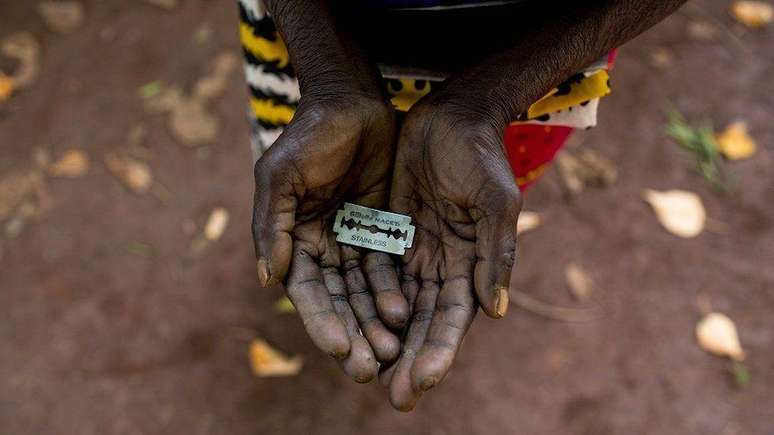The female genital mutilations have been prohibited in Gambia since 2015. The law provides for a fine and a prison, which can be perpetual in case of death
In Gambia, the death of a child of a month after the female genital mutilation caused national confusion and has rekindled the debate on this practice deeply rooted in traditions. The practice has been prohibited by law in the country since 2015.
After the case, the Wellingara police, a municipality in the region of the western coast, announced the opening of an investigation. According to the authorities, the girl suffered a strong bleeding and rushed to Bundung’s maternal-child hospital, could not resist and was declared dead when she arrived.
An internal hospital survey confirmed that he had been mutilated. An autopsy is underway to determine if the procedure was the direct cause of death and two women were arrested for suspicion of involvement in the event.
Human rights defense organizations in Gambia have been constantly positioned against the law and appeal to justice.
THE NGO Women in Leadership and Liberation (Will – Women in Leadership and Liberation) accuses the authorities not to protect children.
“Culture is not an excuse, tradition is not a shield; it is pure and simple violence,” he said in a declaration, asking for a rigorous investigation and the responsibility of the people involved.
The founder of the organization, Fatou Baldeh, told the BBC that more and more children have undergone female genital mutilations in the country:
“Parents believe that children heal faster and that they perform the practice in advance helps to hide it to escape the law.”
Deputy Abdoulie Easay, elected by Kombo North (the electoral district in which the tragedy occurred), asked that the loss was transformed into a turning point:
“The death of this child should not be forgotten. It is a milestone to reaffirm our commitment to protect each child.”
A prohibited but persistent practice
In 2015, Gambia approved a law that forbids female genital mutilation through an amendment to the 2010 female law (Act of amendment of women), after decades of awareness and pressure campaigns of civil society organizations and community groups.
The female amendment law provides for up to three years in prison and a fine of 50,000 Dalasi (about $ 3,640) and can reach life imprisonment in case of death. In addition, those who are aware of the practice and do not report the justified reason can be fined of 10,000 Dalais (about R $ 800).
However, the application of the law remains fragile: from its approval, only two causes and a sentence have been recorded.
La Gambia ratified in 2005 the “Maputo protocol” on women and girls’s rights. Ten years later, in 2015, the country approved the ban on mutilation during the Yaya Jammeh government, which stated that the practice was obsolete and had no basis in Islam.
In March 2024, a bill that tried to revoke the ban generated a strong reaction and protests. In July, Parliament rejected the proposal, under pressure from international activists and organizations such as UNICEF, UNFPA e Human rights watch.
Tradition and social pressure against human rights

Female genital mutilations are often perceived as a symbol of purity, respect and preparation for marriage. In some communities, they are presented as religious requirements, although many Islamic leaders oppose practice.
Practuins are mostly elderly women, with ancient knowledge and social influence. For many families, the renewal of practice is equivalent to breaking with a cultural heritage, at the risk of ostracism within the community.
Figures like Jaha Dukureh, founder of Safe hands for girlsAnd Fatou Baldeh, from the NGO, will guide an intense fight against excision, combining political actions, awareness and mobilization campaigns of young people.
Recent data indicate a gradual decline of the practice among girls under the age of 15, but the change is still slow. The United Nations highlight the need to strengthen the police, involving religious and traditional leaders and support communities in the voluntary retreat of the practice.
The Gambia is a signatory of different international conventions, including the Convention on the Rights of the Child and the Convention on the elimination of all forms of discrimination against women. However, in everyday life, mutilation remains a concrete reality.
For activists, the case of Wellingara tragically illustrates that only the laws are not enough: a profound transformation of mentality is needed, accompanied by a rigorous application, to eradicate the practice.
According to UNICEF, three out of four girls in Gambia are subjected to excision before six years and about 76% of women between 15 and 49 years of age had a practice.
It is particularly common in rural areas, with rates that reach 95% in the lower region, in contrast less than 50% in the capital, Banjul.
Many women listened to by UNICEF and who have declared that it is taboo to speak of female genital mutilation in their communities, for fear of criticisms of strangers or, in countries where the practice is illegal, that family or community members are developed.
Therefore, the available numbers are estimated.
According to the United Nations, although MGF is concentrated in 30 countries in Africa and the Middle East, they are also practiced in some regions of Latin Asia and America, as well as among the immigrated populations in Western Europe, North America, Australia and New Zealand.
From the implementation of the Unfpa-Unicef joint program for the elimination of MGF, 13 countries have approved national legislation that prohibits practice. The program also benefited from over six million girls and women with prevention, protection and care relating to women’s genital mutilations.
About 45 million people in 15 countries publicly declared that they would abandon the practice.
The United Nations estimate that over 200 million girls and women are still victims of sexual mutilations in 30 countries in Africa, the Middle East and Asia.
According to the World Health Organization, the practice includes any intervention that partially or completely removes the external genitalia of women or causes any other injury to the female genitalia for non -medical reasons.
The cost of the treatment of complications deriving from genital mutilations in 27 countries with high prevalence reaches $ 1.4 billion per year.
Source: Terra
Ben Stock is a lifestyle journalist and author at Gossipify. He writes about topics such as health, wellness, travel, food and home decor. He provides practical advice and inspiration to improve well-being, keeps readers up to date with latest lifestyle news and trends, known for his engaging writing style, in-depth analysis and unique perspectives.








